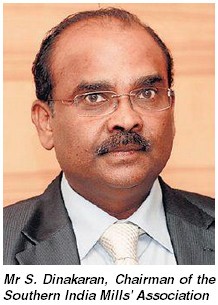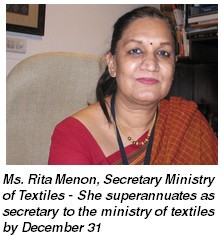SIMA chief urges banks to treat Rs 11,000-cr Q1 loss as exceptional one
 Coimbatore : The Indian textile industry is in a state of flux caught between inconsistent Government policies on the one hand and the severity of slowdown in the world economy on the other.
Coimbatore : The Indian textile industry is in a state of flux caught between inconsistent Government policies on the one hand and the severity of slowdown in the world economy on the other.
The industry, which accounts for four per cent of GDP, 14 per cent of industrial production and around 12 per cent of the country’s total exports is today fighting to survive.
Influence
Since the industry is a net exporter, any policy relating to exports and global market demand has had significant influence on its performance. The Government policy on cotton and cotton yarn exports towards the end of 2010 influenced both the cotton and yarn price creating an artificial scarcity of the produce both within and in the global market.
High volatility in cotton and yarn prices at the beginning of the year, sudden glut in the domestic and international markets, huge accumulation of yarn stocks, closure of dyeing units in all textile clusters – particularly Tirupur and more recently in and around Karur in Tamil Nadu due to environmental issues, have had adverse impact on the industry.
Crisis Beyond Control
The Southern India Mills’ Association (SIMA) Chairman, Mr S. Dinakaran, said the current crisis was beyond the control of the individual mills and, hence, the abnormal loss of an estimated Rs 11,000 crore in working capital during the first quarter of the current fiscal would have to be treated as an exceptional loss by the banks in its books.
‘It’s the worst in history and the magnitude is much higher than the 2008-09 global meltdown,’ the SIMA Chief said.
The industry has invested over Rs 2-lakh crore mostly under the Technology Upgradation Fund Scheme in the last decade and the current debt is over Rs 1 lakh crore.
Out of the 226 listed textile companies in the country, 83 per cent have shown poorer results and 127 companies incurred net loss during the first half of 2011-12.
While stating that the association has represented their case to the Government, the Reserve Bank of India and the Indian Banks Association, seeking timely financial package he said ‘the sympathy element to save this labour-intensive industry is still lacking. Any further delay would lead to irreparable loss.’
Non Performing Assets (NPAs)
To avoid large number of accounts in the sector turning NPA and units getting closed across the country, SIMA suggests that a moratorium of additional two years on repayment of all loans and interest (including TUF loans), with suitable modification in prudential guidelines on restructuring be made and allowed for all textile companies.
Incidentally, in 2008-09, a good number of mills had availed second rescheduling and in some cases, CDR facilities, because of global recession. SIMA requests that such units may also be allowed a moratorium and units with less than Rs 10-crore debt with a single bank be allowed CDR facility.
In view of the steep decline in the price of raw material and finished goods, mills are compelled to adjust with reduction in drawing power resulting in erosion of working capital requirement.
SIMA, while seeking conversion of working capital to term loan (Working Capital Term Loan) for a period of five years with moratorium of six months on behalf of its member mills has drawn the attention of the powers that be towards providing working capital for cotton at 10 per cent margin money and seven per cent interest, to help mills continue to buy cotton.
Reiterating that any delay in providing adequate respite could lead to social and industrial unrest as lakhs of people would lose jobs due to closure of units that faced capital erosion, he said ‘mills are compelled to work at 60–70 per cent capacity to retain workers without any industrial relations problems. But to make it viable, the utilisation levels would have to improve to 85 per cent. This will not only do good to the ailing spinning sector but help the cotton farming sector too.’
Moratorium of 1-2 years will be a breather for industry: Secretary, Ministry of Textiles
In an interview with ET Now and BS recently, Ms. Rita Menon, Secretary Ministry of Textiles, gave her views on textile industry. Excerpts :
 Recently the textile ministry had a meeting with Indian Bank Association along with textile industry representatives to discuss possible debt restructuring and plans for the sector but nothing concrete has really come from this yet. So, what exactly is the demand for the industry and how exactly do you think textile companies will be able to cope up with the demand which currently some of the banks are demanding for?
Recently the textile ministry had a meeting with Indian Bank Association along with textile industry representatives to discuss possible debt restructuring and plans for the sector but nothing concrete has really come from this yet. So, what exactly is the demand for the industry and how exactly do you think textile companies will be able to cope up with the demand which currently some of the banks are demanding for?
The cotton textile industry has been experiencing a gradual slide down from April 11 and a part of the reason is the fact that cotton prices last year were extraordinarily high, so there was a lot of investment in stocks. You are aware that cotton textile mills stock, cotton stocks for a duration of between two to three on an average months to six to eight sometimes, so this inventory has really been very highly valued and that along with the fall in demand both internationally and domestically experienced in the second half of 2011 has actually caused a lot of stress amongst the textile industry.
So, I would not say that nothing concrete has come out because we are in dialogue with the banking sector to reset the loans for a moratorium as they wish for support relating to working capital. And the most important thing is that the assets which perhaps could have been restructured once before should not be called non-performing assets because that does not make that unit eligible for TUFS assistance. So, we are in a fairly advance stage with banking department and with the bankers individually and that is a reason why I have had three rounds of meetings with the bankers.
And the last one was an intensive one with the trade as well on with me in the meeting. So, what is left is the agenda relating to the Reserve Bank of India and we would like to see that on the question of financial prudence we are with them and that the industry is not hurt. But let me assure you, it is not a bail out, it is only a resetting of their commitments and the interest payable would go on as before. What we understand is that the textile minister also has sought restructuring of textile loans and we understand that he has asked for suspension of repayment of the principal amount by the capital intensive textile units for two years from 1st of July which nearly accounts for 90% of the total industry loan. How will this restructuring helps the industry?
Well a moratorium is always kind of a breather and a moratorium of two years or one year which is what the industry wants, subject to us agreeing to it, would actually be a very beneficial because for the system interest payments would continue as before. The industry has not asked us to waive the interest or to provide a financial bailout. It is only a question of supporting them because there has been a very heavy captialisation over the last two years because the textile sector has done very well over the last two years.
How is the situation as far as working capital loans are concerned, what is the cash short fall or mismatch, do you believe the entire industry is having to deal with?
Actually wearing between unit and unit I cannot say that there is a uniform one shoe fit all problem, but certain there are varying levels of commitments on the valuation of the stocks and the mark to market asset value at the moment because cotton indeed has been over Rs 6000 a quintal over the last cotton year and that actually did cause euphoria as well and it also caused a lot of pain. So, it is really because the cotton prices have crashed to almost half the level and the fact that domestic and international demand has slowed down and dried up in some cases that they are having this problem but I have been in touch with most of the units and the position after November is looking much more favourable. But for the period between April and November I do believe that there has been a lot of stress especially and I repeat especially amongst those units in Andhra Pradesh and such regions which have actually gone into and forayed into the modern textile sector for the first time.
Do remember that they were cotton farmers, they moved into ginning and pressing and then they were enthused to move into yarn production and it is these guys and the heavy capital that has been deployed that has actually caused a lot of the difficulties right now that they are experiencing.
The restructured TUFS (technology upgradation fund scheme) that came into effect from this April 1 has failed to encourage the industry, which is still clamoring for more stability. Your view?
I think its popularity has not waned. Only that the time from April has been somewhat an extraordinarily difficult year for the industry. Cotton prices went through the roof; then, all of a sudden, prices literally crashed. There has been a complete dry up of international demand. So, with the yarn inventories that happened till September, high cost of cotton inventories that continued till today and the corresponding problems for the balance sheet, I would imagine that the take-off would be somewhat sluggish to begin with. Having said that, there are movements…. we are monitoring them closely. With the target of Rs 1,972 crore of actual planned subsidy outgo for this year, we may not get there. It will, though, slowly catch momentum.
Can you throw some light on the National Fibre Policy, now that you said that it would finally see the light of day with the roll-out of the 12th FYP (Five-Year Plan)?
The policy is, basically, an outline on the way to go as far as the rates of growth are concerned within the industry across the board. We are also trying to achieve fibre neutrality in the long run; so there is this question of taxes, duties and indirect taxes which any department would hope for and place as an enabling condition. The ministry has put those forward and, formally speaking, these interventions are on a year-on-year basis when the finance bill is being discussed. All other plans will be placed with the 12th FYP. The policy framework is ready, and now it is only on the budgetary allocation to this ministry we will be able to realise certain goals of fresh investments, projects and programmes. It has both a short-term and long-term plan that we have aligned with the five-year plan. We have surpassed some of the targets really in terms of growth rates.
What is the size of allocation that you are looking at?
We are looking at a big-ticket intervention on skill development, promotion of handlooms sector and the ongoing benefits that we plan to give to the weavers in terms of subsidy and interest subvention. We are also looking at a big way at the development of the textile parks that has a great demand. There is a big movement on technical textiles. We have big interventions planned for the jute and silk industry. Then there is huge focus on the revival of Tirupur. So, our total allocation that we requested in the 12th FYP is about Rs 50,000 crore.
What is the status on the high-level committee chaired by you on reviving the Tirupur cluster?
We are now in the process of having the endorsement of the Tamil Nadu government on the technology and the way forward. We would persuade them on creating a common platform for the 20 CETPs (common effluent treatment plants) so that they do not get shut again. We also need the state government to make submission before Madras High Court. The centre is committed to invest money in bringing the CETPs to life, but there is a lot of work required from the state government. So, there is going to be some allocation for Tirupur as well to the tune of around Rs 780-800 crore; add to it another Rs 15-20 crore for us to have a common contractor to help them. So it is an entirely new line.
As the cotton prices crashed like never before this year, would you be considering doling out incentive for the exporters?
No, we are not offering any export incentive. We believe that putting it out in open general license is an incentive enough. The cotton prices today are respectable, they have not come down to the minimum support price and what happened in terms of a price crash were aberrations. It was a never-before scenario, which I, unfortunately, had to witness.
This was really an opportunity for them. And there was this scramble for exports and even for yarn there was a time till April this year when yarn was going out, but there is a complete slump in demand. We are actually very keenly watching China. Because, by now they should have come out with their purchase plan despite the fact that Indian cotton is the cheapest in the world. So all these have brought uncertainty in the industry. Thus we are thinking of restructuring the debts.





